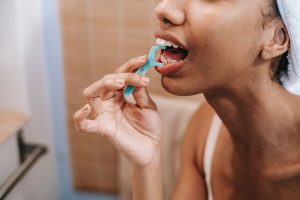
Flossing is an essential part of oral hygiene. While brushing your teeth regularly is important for overall oral health, flossing is important to help remove plaque and food particles from between teeth and underneath the gum line. Flossing is an essential step in preventing tooth decay and gum disease.
Flossing is easy and only takes a few minutes. To get started, wind about 18 inches of floss around your middle and index fingers and hold it tightly with your thumbs. Starting at the back of the mouth, gently guide the floss between the teeth, using a sawing motion. Do not force the floss, but rather gently move it between the teeth and wrap it around the side of each tooth.
Flossing should be done once a day, usually at night before brushing your teeth. Make sure to use a clean section of floss for each tooth and to be careful not to snap the floss against your gums. If you’re having trouble getting the floss between your teeth, try using a floss pick.
When flossing, it’s important to be thorough. Make sure to floss between all teeth all the way to the gum line. This helps remove plaque and food particles from between teeth and the gum line, reducing your risk of developing cavities and gum disease.
If you have questions about flossing, don’t hesitate to contact your dentist. Your dentist can help you find the right type of floss for your teeth and can also provide tips on proper flossing technique.
Flossing is an important part of your daily oral hygiene routine. By being diligent and taking the time to floss every day, you can keep your teeth and gums healthy and free of disease. So don’t forget to floss!
Benefits of Dental Flossing
In this section, we’ll discuss the benefits of flossing and some tips for making it easier and more effective.
Flossing removes plaque. Brushing your teeth helps to remove some plaque, but flossing can help to remove the plaque that gets stuck between your teeth and gums, which is one of the leading causes of gum disease and tooth decay. This can help to keep your teeth healthy and your breath smelling fresh.
Flossing can help to prevent bad breath. Food particles can get stuck between your teeth and cause bad breath. Flossing can help to remove these particles and prevent bad breath.
Flossing can help to prevent gingivitis and gum disease. Plaque can irritate and inflame your gums if it’s not removed, which can lead to gingivitis and eventually gum disease. Flossing helps to remove the plaque and reduce your risk of developing gingivitis or gum disease.
Flossing helps to prevent cavities. Plaque can also build up on the surfaces of your teeth, causing cavities. Flossing helps to remove the plaque and reduce your risk of developing cavities.
Flossing can help to keep your teeth looking healthy and white. Plaque and tartar can build up on your teeth and make them look yellow or discolored. Flossing helps to remove the plaque and tartar, which can help to keep your teeth looking healthy and white.
Flossing can help to reduce the risk of other health problems. Flossing helps to remove the bacteria in your mouth, which can help to reduce your risk of developing other health problems, such as heart disease and stroke.

Making flossing easier
Flossing can be time-consuming and tedious, but there are some tips for making it easier and more effective.
1. Choose the right type of floss for your teeth. There are a variety of floss options available, including waxed, unwaxed, and flavored floss. Talk to your dentist to determine the best type of floss for your teeth.
2. Use an electric flosser. Electric flossers are a great way to make flossing easier and more effective. They can help to remove plaque and food particles more effectively than traditional floss.
3. Try using a water flosser. Water flossers use pressurized water to remove plaque and food particles from between your teeth. They are easy to use and can be more effective than traditional floss.
Making flossing easier and more effective is key, so make sure to choose the right type of floss, use an electric or water flosser, floss before you brush, and take your time.
Clinical Research on Dental Flossing
There has been some controversy in recent years as to the benefits of flossing.
The American Dental Association (ADA) recommends that people floss at least once a day. However, there has been limited evidence to suggest that flossing provides any additional benefit beyond brushing alone.
To address this, researchers conducted a systematic review of clinical trials to assess the efficacy of flossing. The researchers included studies with at least 10 participants that compared the use of flossing alone or in combination with brushing.
The results of the review showed that flossing in combination with brushing reduced plaque build-up by 21.4% compared to brushing alone. This was a statistically significant difference. In addition, flossing reduced gingivitis (inflammation of the gums) by 11.4% compared to brushing alone.
The authors of the review concluded that there was moderate evidence to suggest that regular flossing in combination with brushing provides additional benefit in terms of reducing plaque and gingivitis.
However, the reviewers also noted that the quality of the evidence was generally low and more research is needed to assess the long-term effects of flossing on oral health.
Here is a nice video teaching how to floss your teeth.